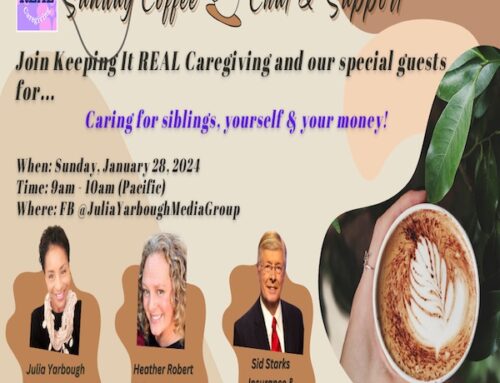Helping elders and disabled stay plugged in

**NOTE: As of Monday, October 11th, 2021, your contributor is experiencing a local Public Safety Power Shutoff. I am grateful to have a generator to provide emergency power for some small household items (coffee/food/water). If you missed this article… now might be a good time for review. Be safe everyone!**
Here’s a question for you? When was the last time you thought about your electricity?
I’m going to venture to guess that if you are in California – especially Northern California – there’s a good chance you think about your power source all the time.
You wonder… ‘Is today the day the utility will issue a PSPS?’
That stands for Public Safety Power Shutoff and it means just that. The power company is going to kill the switch … leaving many of us in the proverbial dark.
Those of us living in the NorCal region have come to anticipate the PSPS when weather conditions are ripe for high fire danger; meaning, hot, dry and/or windy. Over the past several years those conditions feel as if they have become more the norm than the exception.
Cal Fire along with numerous other agencies are still trying to get the upper hand on several massive wildfires tearing through California.
PSPS can sometimes last for days
What happens to individuals who are perhaps older and do not have access to or the ability to use a back-up generator when the power goes out?
And what about those who might have a medical condition that requires electricity to power their equipment or machines?
For these folks, a PSPS is not just an inconvenience forcing one to bathe, cook and clean ‘in the dark,’ it literally could be a matter of life or death.
To learn more about what options folks might have, I reached out to PG&E. I spent time talking with PG&E Spokesman, Paul Moreno.
Now, I realize many people may have a not-so-positive relationship with PG&E based on previous fire incidents in the state. This information is not to discount those experiences. However, the fact remains that for elders living with the possibility of a PSPS, families must still take action.

Paul Moreno/PG&E
I asked him, what should elders (and their caregivers) or those with disabilities do when the electricity stops flowing?
“We understand being without power is at best an inconvenience and in some cases can pose quite a hardship. We have a number of programs to help during PSPS when fire conditions call for that,” explained Moreno.
What are those programs? It turns out, there are several short-term, what you might call ‘stop-gap’ offerings available to those who need help.

Courtesy: Adobe Stock
Medical baseline
For individuals who might rely on some type of medical device which requires electricity, the utility offers what it calls Medical Baseline service.
Let’s say someone has special heating or cooling needs and that equipment sucks plenty of electricity. Or perhaps an individual uses a ventilator or some other type of life-supporting equipment.
To get some economic relief on paying a high bill due to 24/7 equipment usage, families can sign up for assistance. Contact PG&E to learn more.
Okay… so you can get a discount but that still doesn’t account for NOT HAVING power. What then?
Batteries and independent living
There is a fairly recent partnership between PG&E and the California Foundation for Independent Living Centers.
This non-profit began in 1976 to advocate for the needs of disabled individuals.
The mission has grown and the organization now also lends a hand to elders, through a network of regional offices providing some assistance services.
One of which is providing portable batteries to people who need to power their medical devices during a PSPS.
“Those portable batteries are free of charge, they don’t have to be returned and you can hang on to them year after year,” explained Moreno.
If someone is unable to physically get to the location to pick up a battery, Moreno tells me help with transportation can also be arranged.
“Working with the Independent Living Centers throughout Northern California is valuable because the organization is in touch with their clients, so if someone needs help or information it can be provided. Whether it’s transportation, hotel vouchers if necessary and even those portable batteries if they don’t have those already.”
Community resource centers
When you live in high fire danger regions, being prepared ahead of time is crucial; especially for elders and their caregivers.
If someone has lost power and needs a safe, cool place to relocate for several hours or needs to recharge electronic devices, PG&E also sets up community resource centers.
“We station these centers in and near areas where there is a PSPS, where people can go during the daytime to charge devices, get a snack, some cold water and more information about the impacts of the PSPS.”
I spent a little bit of time maneuvering around the PG&E website. All of this information is available online, but here is a breakdown of some steps to take:
PG&E: Make sure you have all of your personal information updated on the PG&E website to be notified for PSPS and know what services are available to you.
If you are an elder or need additional assistance, you’ll want to visit Disability Disaster Access Resources. Click into your region to find your local county office. Mine is Butte County, California. Visit the page for more information and you can also take a survey about preparedness.

Also visit The Disability Action Center to learn what resources are available in your area and how to sign up for additional help. Do this BEFORE there is an emergency so you are already registered in the system.
Call 2-1-1 or text “PSPS” to 211211 for help 24/7. Again – plan ahead and get all the information you need before a crisis hits.
I dialed 2-1-1 to learn exactly what kind of help is available.
The phone rep answered promptly, was courteous and helpful and directed me to my local Disability Action Center and urged me to sign up BEFORE AN EMERGENCY.

“The big effort has been to get people prepared in advance, because it is really hard to provide help in real time if they are not already registered,” says Tara Sullivan-Hames, Director of the Butte-Glenn 2-1-1 Program.
She added, “There is a whole system about to launch that will connect 2-1-1 centers around the state with all the disability action centers to get people the help they need.They should and can call us directly to find out about how to be prepared for a PSPS event and get connected into the services that will be able to get support to them when those events are happening.”
PSPS can of worms
If you have read some of the earlier articles in the KIRC newsletter, you’ll notice the topics are different but there is a common theme and that is: BE PREPARED EARLY before a crisis hits.
Remember, sometimes the individuals who might need the most help are not necessarily surfing the web to find this information. That’s where we all come in. Make a point to check on your elder family and friends. Help them locate and sign up for any available services.
There is no place or time when needing to be prepared is more true than in Northern California during wildfire season.
Which brings me to the next issue I want to delve into: guidelines for skilled nursing homes and assisted living facilities in regards to back-up power supplies. What exactly does California state law require?
Let me hear from you on these topics. Do you have a personal experience involving these issues or do you perhaps worry about the safety of your elder(s) when and if that all-important ‘power to the people’ goes dark?
Email me at [email protected] or leave a comment here. Until next time…
Ciao~





Like our content? We invite you to leave a comment and say hello!